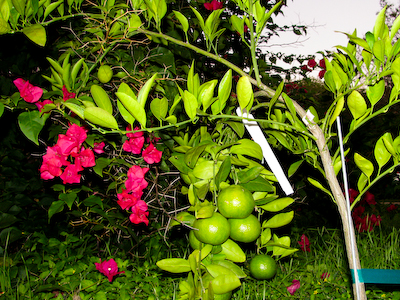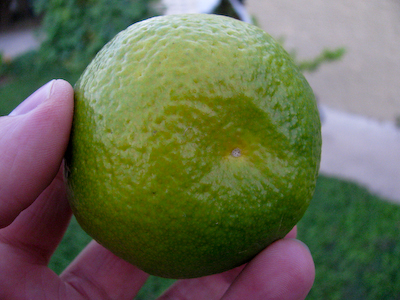In late October I harvested my first crop of Satsumas. I planted a “Dwarf Owari” Satsuma in the early spring of 2008 in the front yard of my east Austin home. That year it produced a few jasmine scented flowers, but no fruit. This year it flowered in late March and produced eight fruit. I eyed those fruit longingly all summer long waiting for them to ripen.
The weight of the fruit nearly bent the tiny tree over to the ground. By the time I picked the first fruit it had come within a centimeter of the earth. The tree is in front of the bouganville.
While researching Satsumas I came across several name variants: Satsuma Orange, Satsuma Tangerine, and Satsuma Mandarin as well as two different Latin names: Citrus reticulata and Citrus unshiu. I also found towns in Texas, Louisiana, Alabama and Florida named for this delicious crop. Of course, the fruit itself is named for Satsuma, Japan.
According to Texas A&M Extension, most Satsumas are hardy down to about 26 degrees Farenheit. Last year I covered the young tree when temperatures dipped into the low 30s. Two newer varieties, “Miho” and “Seto” can survive temperatures as low as 15 degrees.
The inside ripened fully while the outside peel remained mostly green. The green did take on a yellow-orange tinge and fruit felt soft when squeezed gently. The segments had almost no seeds and little of the typical citrus sourness. Commercial producers often use ethylene gas to get the outside to turn fully orange in order to give consumers a more familiar color.
The disjuncture between the color of the inner fruit and the outer peel reminds me of the best orange juice that I have ever tasted, in the Tehuantepec Isthmus region of Oaxaca, Mexico. Often sold on the side of the Pan-American Highway fresh squeezed into plastic baggies, this delicious juice also comes from oranges that stay green on the outside. (Unfortunately for the growers, highway juice sales are one of the few ways to sell the fruit. The wholesale prices that growers receive in the region have dropped so low that it often doesn’t even cover the cost of harvesting the oranges, so they are often left on the trees to rot.)
I have since expanded my citrus plantings to include kumquat, a potted Mexican lime, and a neglected “Miho” Satsuma waiting to be transplanted. As long as I provide some supplemental water, they seem to thrive in the scorching Austin summers. Not a bad trade off for the rhubarb that I miss from Wisconsin.



